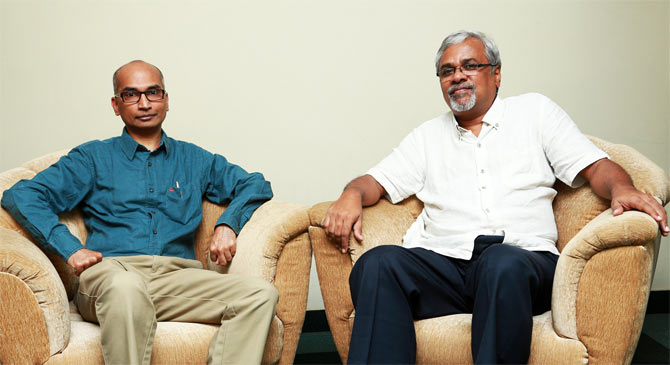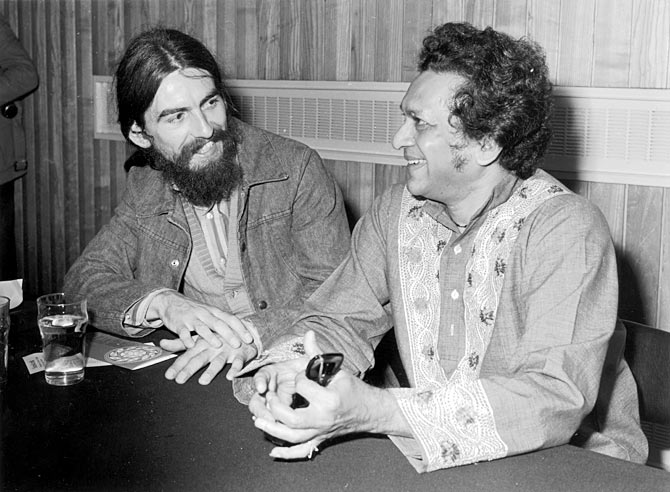 | « Back to article | Print this article |
'Indian entrepreneurs have 100 times more opportunities today'
Senthil Kumar, the co-founder of Real Image Media Technologies, is a pioneer in bringing the latest audio and video technology to India.
He became an entrepreneur when he was still an engineering student. He spotted the technologies of the future before most other people did.
He designed his own programmes, used technology that India had not seen till then, and made a sort of technology revolution in the field of audio and video.
He comes from a family of entrepreneurs. His grandfather A V Meiyappan Chettiar started the well-known AVM Studios that made films. His father, Arun Veerappan, directed a few Tamil and Hindi films.
In this interview, Senthil Kumar talks about his fascinating journey as an entrepreneur that started as a student.
Passionate about technology
I think technology is in my genes. As a child, I used to take apart toys to see what was inside, and later on in school and college, I was involved in any activity that had something to do with technology.
I joined REC, Trichy in 1982 to study Computer Science, the very first batch of Computer Science in India.
At that time, my father was directing a film. I was interested in the technology aspect of filmmaking, specifically sound.
When I began working with him on the audio, I found that sound technology was so primitive and backward here. As there was no Internet at that time, I started reading books and magazines on the latest audio technology.
It was the mid-eighties, the peak of India's isolation from the rest of the world. Technology in India was stuck in a time warp that was 20-30 years behind the rest of the world.
Setting up
My plan was to go abroad and do my Masters in Computer Science but before going, I wanted to start an audio studio in Chennai that had the latest audio technology.
In 1986 I put in about Rs 6-7 lakh and got a loan of about Rs 30-40 lakh. I could set up the studio on land we owned. It was the first studio to be put up far away from Kodambakkom.
I did everything on my own, recruited a couple of people and imported some machines from the US and from Europe.
Media Artists was a studio for recording dialogues, music and film mixing.
We used multi track recording which was not done anywhere in India then. It worked quite well and the quality of sound was quite good.
'There are always people who trust a student who is passionate about technology'
Industry reaction to new technology
What we used was a new technology which the film industry was not familiar with, and they didn't trust us.
The industry was very tradition bound but there are always people who trust a student who is passionate about technology. Slowly, many started understanding that Media Artists meant quality.
With audio engineer Sridhar joining us, we could bring about a change in what sound the audience heard in the theatres.
Digital technology
Digital technology was becoming popular in the rest of the world, and for the first time, a studio in India had digital technology and that was our Media Artists.
With my background in computers, I started to programme software for special effects in films. I developed this on my own, and that was SFX.
We broke even fast, though we did not make much profit. In 1991, when things were going really well for Media Artists, there was a major fire and by evening, everything was burnt down.
I was unfazed as we had the insurance. Though we did not get the entire money back, I could start the studio with the latest digital equipment and rebuild the studio in a better way.
Jijo was making Bible ki Kahaniyan on Doordarshan at that time, and he wanted help from our studio. We felt editing the film on a computer could ensure high quality work.
In fact, outside of the US, nobody was using computer-based technology in editing.
Avid Technologies and Real Image Media Technology
On research, I found that a company called Avid was the best for this kind of work. I decided to buy the machine for around Rs 3 lakh and set it up on our own.
When Avid came to know that we did everything on our own, they wanted us to promote them in India.
I had been meeting Jayendra, an ad filmmaker, regularly. When this opportunity with Avid came, we decided to join hands to start Real Image to promote Avid in India. That was in 1991.
'George Harrison was extremely happy with the way Sridhar recorded in our studio'
Bringing DTS to India
With digital technology, we were creating excellent sound in the studio, but theatres were not equipped with good sound systems, and it sounded just average.
We looked for a good option. Dolby was one but they felt India was not ready for digital which put me off completely. I found a smaller company called DTS.
Jayendra and I visited DTS in the US and the guy who started it told us, I know India is a huge market but my hands are full in the US and I have no resources to work in India.
So, we were given a licence so that he got a royalty every time DTS was installed in a theatre in India.
We bought 20 units and installed them in theatres around Tamil Nadu and Kerala on our own and asked them to pay us the money when a film works well. We had taken around Rs 70-80 lakh -- all the money we had made from Avid -- and put it in DTS.
We also started working on a few films like Kamal Haasan's Indian and Priyadarshan's Kaala Paani with 5.1 sound track.
Indian did very well in Hindi too. Some of the distributors who heard the sound wanted it in Mumbai; some theatres in Maharashtra and Gujarat wanted it too.
We also learnt to mix songs in 5.1 for the first time in the world! As you know, the rest of the world does not have songs in films. It was very challenging and educational.
It was a tough period financially. Luckily, DTS did very well and soon there were several thousand DTS theatres all over India.
George Harrison of Beatles comes to Media Artists
This happened in the mid-90s. It was the central government that made a booking at Media Artists and insisted that Sridhar did the mixing.
When we walked into the hotel room, George Harrison and Pandit Ravi Shankar were waiting for us.
It was a major shock for us. Anushka was a little girl and was running around.
It was an amazingly good recording for a week and one whole evening. We had a fun session with them.
George Harrison was extremely happy with the way Sridhar recorded in our studio.
It was top secret and only after they left, the news appeared in the papers. So, there were a lot of angry friends encountering us after that.
Foreseeing digital cinema and developing Quebe Technology
We were doing very well. A lot of films came from Mumbai to record here in DTS. Sound had gone digital and we knew the next step was digital cinema, as the cost of showing would be lower and quality, higher.
Then, we thought we should not bring technology from outside but create our own.
Coincidentally, Rajesh Ramachandran from the US reached out to me and said he was interested in media technology and wanted to develop digital cinema technology.
He moved to India for a few years and we set up a team and developed the Quebe Technology in 2001. We launched it in 2005.
We controlled all the theatres with our technology centrally and used digital advertising as a revenue model. Ads were sent based on rules to all the theatres that had Quebe technology.
We even sold it to other countries and did very well in China, Korea, Italy, Spain, Portugal, Canada, and even the US. But our primary interest is the Indian market.
'The initial days of struggling to repay loans taught me a lot about financial discipline'
The technology of the future
Over time, we became friends with Dolby again. We thought the 3D sound technology, Atmos, could revive film sound by one more step.
Atmos is an amazing jump in flexibility and quality. Sound with Atmos will be there for the next decade. We have 4k kind of cinema and Atmos kind of sound. The human eye can't see any better than this and the human ear can't hear any better than this.
On the other hand, there are many ways you can innovate technology to help filmmakers in making movies.
There will be a time when you won’t have to shoot much; everything can happen on the computer. It is almost certain that that is the way filmmaking will go.
Advice to budding entrepreneurs
The initial days of struggling to repay loans taught me a lot about financial discipline.
I am pretty conservative in my thinking but I never had a question in my mind about whether it would work. I could see the future in technology always and I had a strong conviction that I would not fail.
Our method is to find out what will work in the future, then make it happen, and along the way, make money!
Finding new technology and new ideas, is what we are passionate about, and not making our company a 100 crore one!
It is possible to make money if you are doing something that excites you and what the market wants or you feel the market will want.
So, I would say, do what you enjoy doing and money will be a by-product. Don't look for ways to make money. I don't think that will work for an entrepreneur.
Today, an Indian entrepreneur has to think global; they shouldn’t be constrained by boundaries. Therefore, opportunities are 100 times more compared to when I started.



